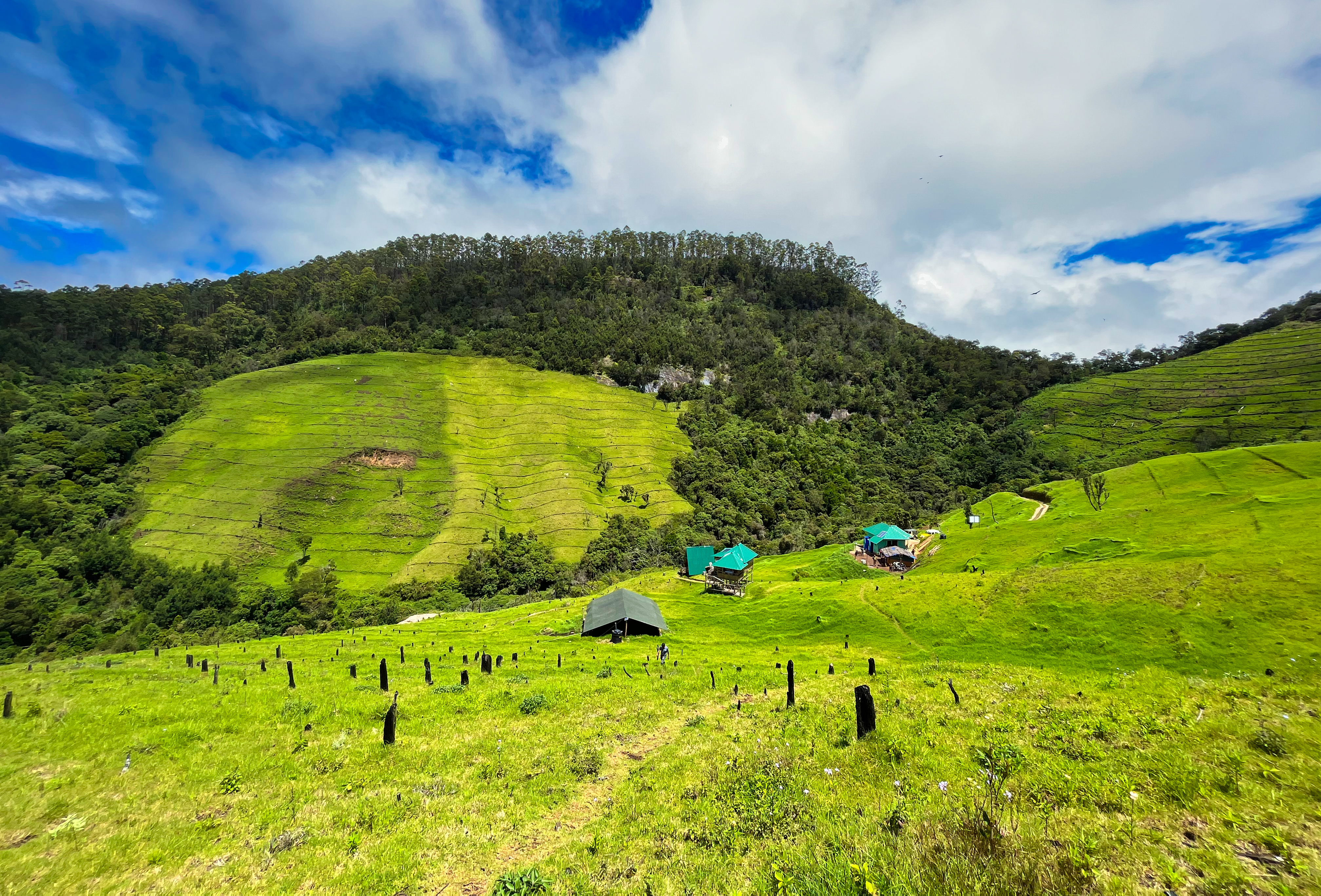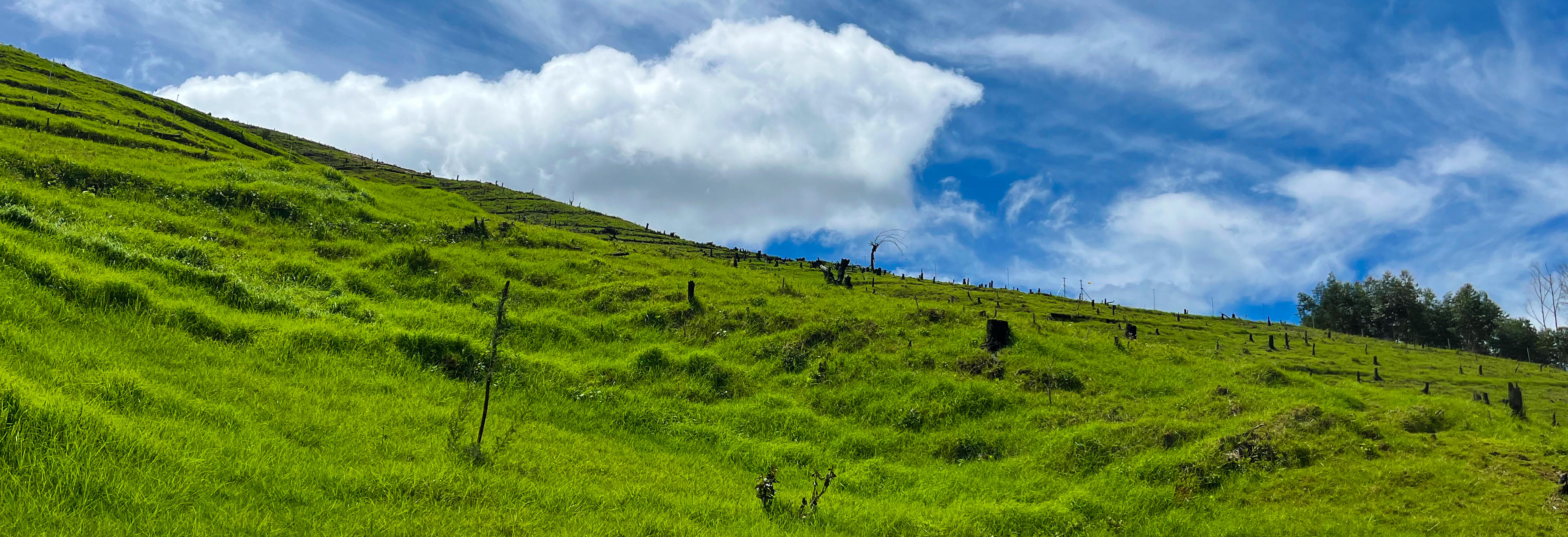- by Parth Joshi: Energy, Environment and Resilience team at UNDP
Bringing back the green: Eco-restoration of Shola grasslands in Kerala
July 18, 2022

Different stages of restoration. The darker coloured meadows are recently restored, while the light green colour denoted past restoration work.
As the monsoon clouds roll over the bright green meadows, the twenty-odd staff of the Kerala Forest Department pause for a moment to look at the natural beauty around them. Barely three years ago, this patch of land was overrun by wattle, an invasive tree species that destroyed the native vegetation. With their efforts, the first signs of biodiversity restoration are now beginning to show.
Lying in the state of Kerala, Anamudi Shola National Park is part of the Western Ghats, a mountain range parallel to India's western coast. It is one of the world's eight 'hottest hotspots' of biological diversity, home to more than 300 globally threatened plant and animal species.
The region is known for Sholas – forests interspersed with grasslands found in Western Ghats' high altitudes. They are a habitat for rare and endangered wildlife and support the ecosystem by acting as water reservoirs.

Shola grassland ecosystems are found in high-altitude mountain ranges of the Western Ghats in India above 1,000 meters
However, in the past, many of these grasslands were converted into farmlands and timber plantations to meet human needs. Many planted species like Eucalyptus and Acacia were not native to the region. They were brought from other countries like Australia. While there were short-term economic gains, these exotic species turned invasive over time. They depleted the nutrients from the soil and hampered the growth of native species leading to loss of biodiversity, including wildlife that depended on the grass for fodder, and ecological imbalances like water scarcity.
In 2019, a forest fire destroyed around 50 hectares of invasive forests in the park. The forest department looked at this incident as an opportunity to rebuild what was lost. Towards this, an eco-restoration effort as part of the ongoing India High Range Mountain Landscape (IHRML) initiative by the Global Environment Facility, Ministry of Environment, Forest and Climate Change, UNDP, and the Government of Kerala was launched.
IHRML aims to develop an effective multiple-use management framework for conserving biodiversity in the mountain landscape of the Western Ghats.
Participation of the community, who are primary users of natural resources and possess traditional wisdom associated with their sustainable use, was also critical to the restoration efforts. An eco-development committee named Haritha Vasantham (Green Springs) was formed, comprising of youth from the nearby villages, who were trained and employed to carry out the restoration, thereby generating livelihood opportunities.
“What you see here now is the result of hard work by our local youth. They undertook the plantation of native grasses, monitored the growth of invasive species, and documented the progress,” informs S.V. Sunil, Chief Executive Officer, Anamudi Forest Development Authority. “In addition to the grasses planted by us, many native flowering plants like the Neelakurinji (Strobilanthes kunthiana), which bloom once every 12 years, have started growing on their own,” he adds.
“When I started this job, I was unsure of why we were doing it. We kept digging and planting wild grasses. But now, when I look at the meadow, I understand how the forest had taken away our grasslands. A stream that had dried years ago has been revived. This has convinced people in our village that restoring these grasslands is important for us,“ says Sarath, a young volunteer from Haritha Vasantham.
To ensure that the grasses attain proper growth and are not wiped out due to overgrazing or diseases, the IHRML initiative has also established a nursery, where saplings are nurtured for 3 months and then transplanted as per requirement.
Restoration efforts are long and complex since many natural variables are involved, and factors like disease outbreaks can undo years of hard work. But if successful, they generate many important benefits for both nature and people. For example, wildlife like the endangered Niligiri Tahr now have more area for fodder, and communities enjoy increased water supply and protection from natural disasters like cloudbursts.
Nilgiri Tahrs are found only in the high-altitude grasslands of Western Ghats. Today, they are endangered due to the loss of habitat.
Looking at the velvety green grass, one can make out different shades of green. The lighter ones denote areas where restoration has been successful, and the darker hue marks areas where new plantations have been carried out.
Buoyed by the success of this pilot initiative, both the government and communities are enthusiastic about upscaling these efforts to restore more Shola ecosystems.

 Locations
Locations